Teague, Texas, Freestone County. (original) (raw)
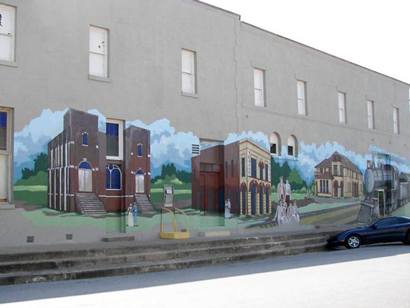
History in a Pecan Shell
First settlers moved into the area prior to the Civil War and later a small community named Brewer sprang up. Things got going in 1906 when the Trinity and Brazos Valley Railway arrived. The railroad built a machine shop here and did repairs on their cars here. Railroad magnate B. F. Yoakum renamed the town to Teague in honor of his mother Narcissus Teague. (See "renaming" in forum below.)
The railroad influence is still felt today with a notable presence of BNSF and the old railroad depot museum - including the nearby Hotel Teague - a vacant ruin with some nice brickwork.
As a shipping center for local cotton farmers, Teague prospered. By 1914 it had population of 3,300 - which rivaled many county seats in Texas at that time. Teague had electric lights, a waterworks, an ice factory, three banks, two gins, a cottonseed oil mill, three newspapers -a daily and two weeklies. Teague, like most of Texas, prospered through the 20's - right up until the Great Depression.
Cotton bottomed out and the population melted away. From 140 businesses in 1931, there were only 100 five years later.
With the increased mobility after WWII more people left and more businesses went under. In 1975 the population was still a respectable 2,800. By 1990 the population was back to 1914 figures of over 3,200 and it has inceased further to over 4, 500.

The Railroad Depot in the early 1900s
Pphoto courtesy texasoldphotos.com
Historical Marker: B-RI Railroad Museum, 208 S. 3rd Ave, Teague
Town of Teague
In 1905 this town was a drowsy country village called Brewer-- named for 1835 land grantee Green Berry Brewer. It had been settled in the 1870s. Prosperity rolled into Brewer in 1906, however, when the Trinity & Brazos Valley Railroad selected it as site for the railroad stops and as the main division point between Houston and Fort Worth. The town was speedily renamed for the Teague family, relatives of noted railroad builder B. F. Yoakum. In August, 1906, promoters held a town lot sale. Customers arriving on a special train were met by a band playing "Dixie" and before the day was over, they had consumed 5,000 pounds of barbecue. By 1907 Teague was transformed. Dozens of brick buildings were under construction, population soared, and the Ten Thousand Club advertised "10,000 by 1910". Teague's first opera house was soon projected, and citizens once watched 2 merchants struggle happily to the bank carrying large baskets of "greenbacks". During the first decade of the 1900s, population hovered at 5,000 but then momentum decreased. With the decline of passenger train service, Teague began to dwindle. Today it is again a quiet town and the railroad depot-office building houses a museum.
(1969)
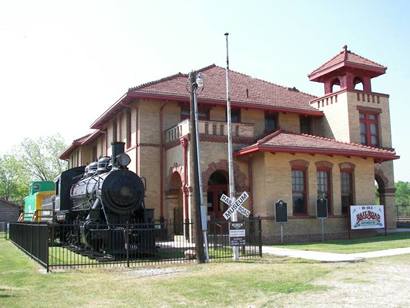
(The restored depot)
Burlington-Rock Island Railroad Museum
National Register of Historic Places
208 S. Third Ave.
254-359-4100
the railroad museum.com
Historical Marker: B-RI Railroad Museum, 208 S. 3rd Ave.
Old Division Point Office for the "Boll Weevil" Railway
Important Texas transportation artery. Chartered as Trinity & Brazos Valley Railway. Nicknamed for special trains roaring down its tracks, taking men to "Boll Weevil Conferences"-- in turn of century alarm over pests attacking cotton and the economy. Another nickname for road was "Turnip & Bean Vine".
The T. & B.V. was founded by an investor-statesman, Col. Edward M. House, famed for his national political power as advisor of U. S. President Woodrow Wilson. House's associates included Frank Andrews, formerly assistant attorney general of Texas; Robert H. Baker, statesman and insurance executive; and Benjamin F. Yoakum, lifetime railroad man and agriculturist. Road was built 1902-1907 from Houston to Cleburne, and with special trackage arrangements it became a short-cut hauler from Galveston to Fort Worth and Dallas. It introduced diesel passenger streamliners to Texas; belonged to Burlington-Rock Island complex during most of its first 60 years of service. Texas attained a peak of 17,078 miles of railroads in 1933. Trains still have respected roles in freight hauling. But the era of regulating family clocks by passage of the "Boll Weevil" or some other train is now largely a matter of warmly-cherished history.
(1968)
[See "The Boll Weevil" by Mike Cox]
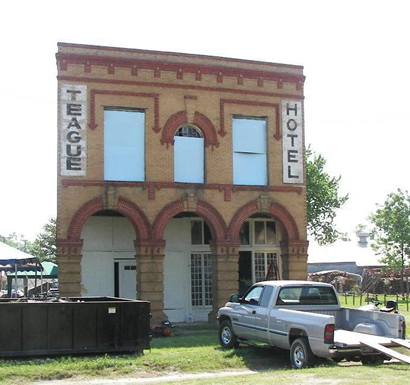

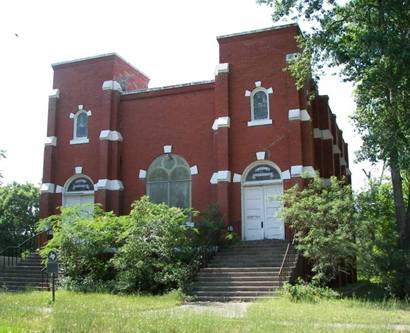
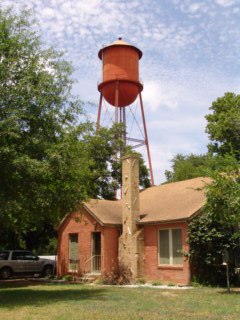
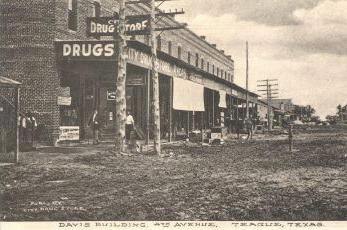
City Drug Store & Davis Building on 4th Avenue, early 1900s
Photo courtesy texasoldphotos.com
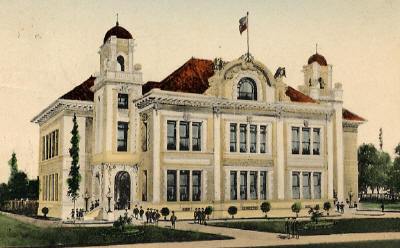
Historical Marker: 7 miles W on US 84, 1.5 miles NE on FM 1366
Cotton Gin Cemetery
Margarette Wills, her slaves and her son James S. Wills came to this area in 1845. Dr. James S. Wills is credited with the establishment of the Cotton Gin community in 1848. According to family history, Dr. Wills gave the land for a public cemetery with separate sections for Anglo and African Americans. Though it is likely that there were earlier burials, the oldest legible gravestone in the Anglo section is that of Mary Manning, who died in 1854 at 59. The next identifiable death date is that of an infant daughter of J. W. and A. A. Story, buried in 1858. Among the military veterans interred here is Abraham Roland (ca. 1794-1868), who fought in the War of 1812. There are at least 67 Civil War veterans interred here, as well as veterans of other major conflicts.
(1999)
More Texas Cemeteries
Teague, Texas Chronicles
- "The Boll Weevil" by Mike Cox
One of many long and short lines serving Texas was the Trinity and Brazos Valley Railway, better known in the early 1900s as "The Boll Weevil."



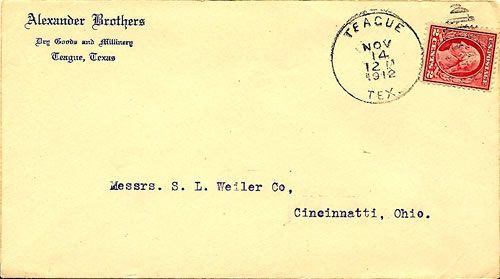
Teague, Texas Forum
- Subject: Teague Hotel
I enjoyed reading your article about my home town, Teague. However, I'd like to let you know that the Teague Hotel has now been renovated, and is open for renting. There are several rooms on the upper floor, and the downstairs works as a venu for things like parties, bridal showers... etc. Check it out... it's FABULOUS. - Tina Cobbs, May 3, 2022 - Renaming of Brewer, TX to Teague, TX in 1906
In researching the family history of the Teague family for many years, I have found once a mistake is made, it continues until a researcher provides the right documentation.
The sentence "The town was renamed after Betty Teague, a niece of railroad magnate, B F Yoakum." is in error.
B F Yoakum renamed the town Teague in honor of his mother Narcissus Teague Yoakum (and not after Betty Teague, the daughter of John Fowler Teague, brother to B F Yoakum's mother).
Reference: Volume 1 History of Freestone County, TX published by Freestone County Historical Commission in 1978.
Page 171 provides transcriptions of the Teague Chronicles during the early days of Freestone County. The following detailing the renaming of Brewer, TX to Teague, TX:
"The name of the new town site was soon changed from Brewer to Teague by B F Yoakum, one of the officials of the T &B . V. Railway, and the son of Narcissus (Teague) and Franklin L Yoakum. His father was a minister of the Cumberland Presbyterian faith who, at one time, served as President of the pioneer Trinity University when it was located at Tehuacana, Limestone County, Texas. He had hoped that his son would follow in his footsteps and also become a minister, but the boy's hopes and dreams were fixed entirely on railroading.
Yoakum honored his mother by giving this new town site her maiden name of Teague."
I appreciate what you do. - Richard Teague, Plano, TX, November 29, 2019 - Subject: Jack Ellis Scott
My name is Sam Scott. My father lived in Teague and I assume went to Teague High School. He passed away when I was 11. I never had the opportunity to talk to my father about his childhood and growing up in Teague. He always worked out of town and we lived in Jonesville, Virginia. I have tried, through the school to get information about high school annuals but because he probably attended school in the 1920s It's hard to find those years. If you have any information about a place where I could get or look at an annual I would really appreciate an e-mail from you. If It helps My grandfather was Samuel J Scott, my grandmother was Mary Ethel Scott. I was told as a child that my grandfather was the road commissioner for the county. Thanks. Sam Scott, June 19, 2006, E-mail: ps49@verizon.net
Texas Escapes, in its purpose to preserve historic, endangered and vanishing Texas, asks that anyone wishing to share their local history, stories, landmarks and recent or vintage photos, please contact us.
